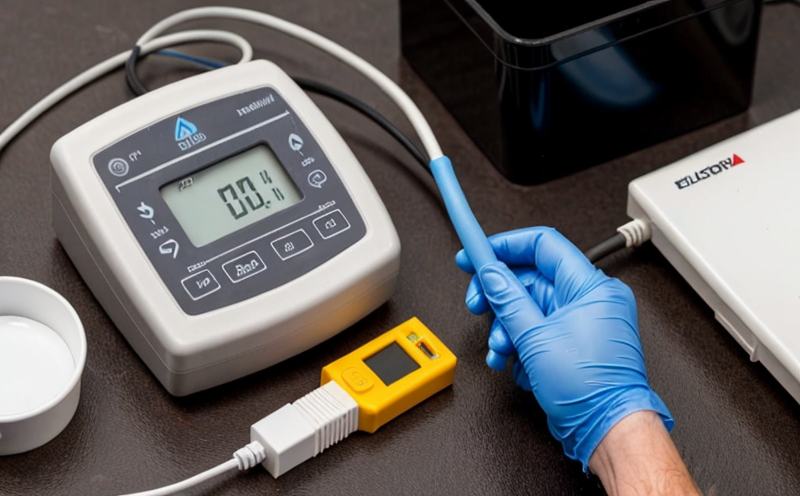ASTM G59 Electrochemical Testing by Polarization Resistance
The ASTM G59 standard provides a method to measure the corrosion resistance of coatings and alloys using polarization resistance. This technique is widely used in industries where materials are exposed to corrosive environments, such as marine, aerospace, and chemical processing sectors.
This testing procedure involves exposing metal specimens to an electrolyte solution under controlled conditions of current density and time. The goal is to assess the stability and durability of coatings against corrosion by measuring the resistance exhibited at various levels of polarization. This approach helps in identifying the most suitable protective measures for materials that will be used in demanding environments.
The ASTM G59 method is particularly effective when applied to materials like steel, aluminum, titanium, and their alloys. It is also useful for evaluating coatings such as paints, varnishes, anodized films, and other surface treatments. The testing process provides insights into the protective properties of these materials under specific environmental conditions.
The standard specifies that specimens should be prepared according to ASTM G51 guidelines, ensuring a consistent starting point for all tests. Specimens are then exposed to an electrolyte solution, and current is passed through them at various levels of polarization. The resistance measured during this process indicates the materials' ability to resist corrosion.
The results from ASTM G59 testing can be used to compare different coatings or alloys under controlled conditions. This information is valuable for R&D engineers in selecting the most appropriate material and coating combinations for specific applications. Additionally, compliance officers use these test results to ensure that products meet regulatory standards and quality requirements set by industry bodies.
The accuracy of ASTM G59 testing relies heavily on precise control over the experimental conditions such as temperature, humidity, and current density. These parameters can significantly influence the outcome of the tests, making it crucial for laboratories to adhere strictly to the standard's guidelines. The use of high-precision equipment is essential in achieving reliable results.
The ASTM G59 method offers a quantitative measure of corrosion resistance that is directly applicable to real-world scenarios. By understanding how materials behave under controlled conditions, manufacturers can make informed decisions about material selection and coating processes. This leads to more durable products that are less prone to premature failure due to corrosion.
One of the key advantages of ASTM G59 testing is its ability to provide a standardized method for comparing different materials or coatings. This ensures consistency across different laboratories, which is critical in regulatory contexts where compliance is mandatory. The test results can be used to benchmark performance against industry standards and best practices.
The process also allows for the identification of optimal polarization levels that minimize corrosion while maintaining material integrity. This information can guide further research into developing more effective coatings and alloys. In summary, ASTM G59 testing by polarization resistance is a vital tool in ensuring product quality and reliability in corrosive environments.
Benefits
The benefits of ASTM G59 Electrochemical Testing by Polarization Resistance extend across various aspects of material science, production processes, and regulatory compliance. Here are some key advantages:
- Enhanced Corrosion Resistance: Provides a quantitative measure of how well materials resist corrosion.
- Material Selection: Helps in choosing the most suitable material for specific applications based on their corrosion resistance.
- Process Optimization: Assists R&D teams in optimizing coating processes to improve durability and performance.
- Regulatory Compliance: Ensures that products meet stringent industry standards and regulatory requirements.
- Cost Efficiency: Reduces the likelihood of premature product failure, thereby minimizing maintenance costs and downtime.
- Enhanced Reputation: Demonstrates a commitment to quality and reliability, enhancing customer trust and satisfaction.
Overall, ASTM G59 testing by polarization resistance is an essential tool for maintaining high standards in material science and engineering.
Industry Applications
- Marine Industry: Evaluating coatings used on ships, offshore structures, and marine equipment to ensure durability against saltwater corrosion.
- Aerospace Sector: Assessing materials for aircraft components exposed to various corrosive environments during flight.
- Chemical Processing: Testing alloys and coatings used in chemical plants to withstand aggressive chemicals and harsh conditions.
- Automotive Industry: Evaluating the corrosion resistance of automotive parts, particularly those exposed to road salt and other corrosive elements.
- Offshore Oil and Gas: Ensuring that equipment used in offshore platforms is resistant to seawater and industrial chemicals.
- Construction Industry: Assessing the durability of materials used in infrastructure projects exposed to environmental factors such as salt, humidity, and pollution.
The ASTM G59 method plays a crucial role in these industries by providing reliable data that can be used to enhance product performance and extend service life.
Quality and Reliability Assurance
ASTM G59 Electrochemical Testing by Polarization Resistance is integral to quality assurance programs in numerous industries. This testing method ensures that materials used in critical applications meet stringent standards for corrosion resistance. By adhering to ASTM G59, laboratories can provide accurate and reliable data, which is essential for maintaining high-quality products.
The standard specifies precise procedures for sample preparation, test conditions, and measurement techniques. These guidelines ensure consistency across different testing facilities, reducing variability in results. This level of standardization is critical for industries where product reliability directly impacts safety and performance.
Compliance with ASTM G59 also helps manufacturers meet regulatory requirements set by governing bodies such as the International Organization for Standardization (ISO) and industry-specific standards like ASME and API. Meeting these standards enhances a company's reputation, fostering trust among customers and stakeholders.
In addition to ensuring product quality, ASTM G59 testing supports continuous improvement in material science and engineering. By identifying areas where coatings or materials can be enhanced, this method contributes to the development of more robust solutions that withstand harsh environmental conditions.
The results from ASTM G59 testing are widely recognized and accepted by regulatory authorities, further emphasizing its importance in maintaining high standards of quality and reliability. This recognition adds value to products, enhancing their marketability and competitiveness in global markets.





